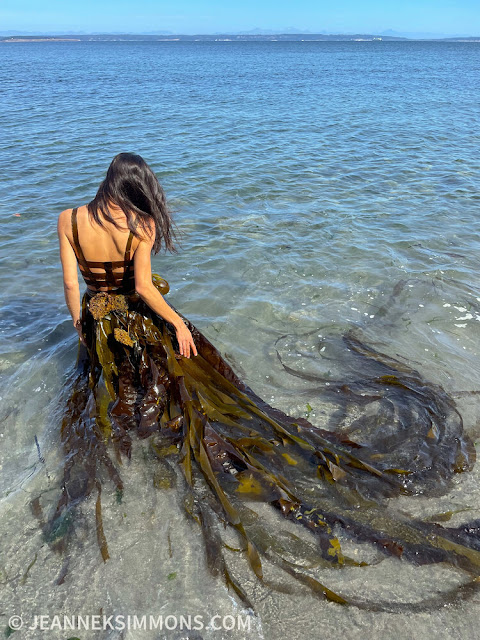While
walking the beach at Fort Worden I picked up a small unidentifiable bone a few
days back, and yesterday found an intact cockle clam shell. They were cool
enough they went straight to the “pool room.” Actually, they went straight
to the studio for an attempt at a still life.
A number of
exposures later I got a few I like. A rare thing around here since the camera has
been gathering dust along with everything else. Plus, I have an inbuilt
loathing of sea shell still lifes. Getting a photo of the finds that doesn’t
want to make me or anyone else ill was a main priority. A tall order, but
I am hopeful these shots - overshot.
 |
Beach Find Iteration #1 Photo by Kevin Imper |
 |
Beach Find Iteration #2 Photo by Kevin Imper |
Why do I react negatively when confronted with beach gleanings – collections and photos? Shells and other miscellaneous beach residue have always excited me at the moment of
discovery. But that excitement is always short-lived once the moist richness of
the beach environment is left behind. Drawer bottoms become littered with
treasured mementos - sand dollars, clam shells, sea glass, and colored smooth
stones, all having become dull and lifeless. So different from the conditions of their vibrant discovery. Found treasures are ultimately tossed out with the thought, “why did I ever collect that?” Artistic renderings of the same usually
fall short of success and only serve to remind me of the bottom of
my junk drawer, with all of its dusty lint-covered, once treasured, pathetic, underperforming
mementos of once-rich times.
So,
how can we respond with fresh eyes to the once fascinating objects found
on the beach? We could try to ignore the just-found associations.
Maybe use the objects to express something newer, or something bigger. Present
the finds to represent a theme of the oceanfront experience rather than the
objects themselves. Many aspects of that unique boundary have a universal draw
for humans, creating for some an overwhelming reverence. Just being on the edge
of mystery and the power of nature’s force can truly amplify our senses while
at the shore. The sense of power that pushes secrets of that marine world up onto
the beach for the beachcomber to find, revealing alien life at its end, or the
living dwellers of the intertidal space.
Possibly
the artist can expand the theme by using the objects to express the vastness of
the forces and of time itself as a way to illustrate human’s fleeting and minor place not
only in the world we exist in, but in the universe. Humbling, eh? Andrew Wyeth put the elements that draw us to the timeless aspects of our shores
into many of his paintings. They are powerful, both abstract and deceptively realistic.
 |
River Cove - Andrew Wyeth 1958
|
I
was going to import an image of his 1975 painting called Flint but
copyright issues got in the way. Here is a link if you would like to check it
out:
https://images.app.goo.gl/DVZP7vVTDCNedMqh7
Found
objects might also be used to express the overwhelming organic nature of the
shore, the gloriously fecund richness of the earth, and of life’s organizing
forces at work throughout time. In this case I am talking about the self-conscious
monkey {us) viewing and interpreting this environment using our own monkey
experiences as the key to visual presentation. Our esthetic sense that
naturally puts mankind at the center of all things. Edward Weston’s
photographs of his shell grouping, and his Chambered Nautilus are
more in this vein, provoking wonder but depending on our subconscious cues for meaning.
 |
| Shells - Edward Weston 1927 |
My short series of the recent beach finds are all about exploring this Weston esthetic.
This next image includes two of the props from the earlier photos, but adds a third one,
another flint stone gathered in England at some point. Probably gleaned while walking the rocky beach along the Thames Estuary.
Seeking to avoid earlier accusations of obscenity in the first two images, I flipped the cockle.
 |
Beach Find Iteration #3 Photo by Kevin Imper |
 |
Beach Find Iteration #4 Photo by Kevin Imper
|
 |
Beach Find Iteration #5 Photo by Kevin Imper |
It
has been several months since I posted this photo of the clam shell chorus
line. I like the photo but it hasn’t been wearing well. It is time to play with
the composition and cropping. Analyzing the original post it is easy to imagine
the image without the uppermost clam shell. Being brighter it conflicts with
the march of the shells out of the void and also fights with the foreground for
the viewer’s attention. So let’s eliminate it.
When
cropping, I find my personal preference seldom agrees with that of the most
common cropping suggestions of photo editing programs. But the program presets
are a good starting point, even if usually ignored. They are offered up with
the weight of three-hundred years of historical analysis and should at least be
considered.
Here
is my rethought composition:
 |
| Iteration #5 Rethought - Photo by Kevin Imper |
 |
| Beach Finds - Three Piece |
Photo by Kevin Imper
 |
| Two Piece Beach Find with Pearl |
Photo by Kevin Imper
 |
Beach Finds - In the Corner of Your Mind Photo by Kevin Imper |
 |
Beach Find Iteration #7 Photo by Kevin Imper |
@kevingimper






















